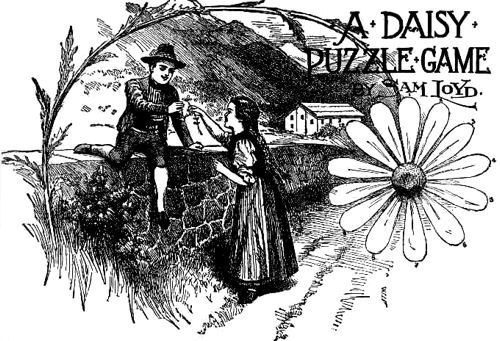



REFERRING TO THAT oft-repeated query as to the origin of certain puzzles, occasion is taken to say that I have fashioned quiet a number of Swiss puzzles, from flags to Sweitzerkase and Alpine roses, and believe my penchant in that direction may be traced to a little incident which occurred over a quarter of a century ago.
With a party of tourists who were doing the Alps in the summer of '65, and who had undertaken the long tramp over the snows from Altdorf to Fluellen, to see the historic spot where Tell used to shoot apples, we were enjoying a rest, after a long day's journey, when spying a little peasant girl gathering daisies, and, thinking to amuse the child, I showed her how to prognosticate her matrimonial future, by plucking off the petals of the flower to determine whether she would be a bride of the “rich man, poor man, beggar man or thief.” She said that the sport was well known to the country lassies, with the slight difference that a player was always at liberty pluck a single petal or any two contiguous ones, so that the game would continue by singles or doubles until the victorious one took the last leaf and left the “stump” called the “old maid” with your opponent.
To our intense astonishment the pretty maiden, who could not have been more than ten years of age vanquished our entire party by winning every game, no matter who played first.
I did not study out the trick until we were back in Luzerne, but I was so bantered by the party that I made quite a point of investigating it, but never had the satisfaction of beating the little mathematician at her own game. I will say, incidentally, however, that I returned to Altdorf some years later and visited the locality of my previous defeat, and it would give me pleasure and add to the romance of the story if I could say that I found little Gretchen developed into a beautiful mountain fraulein, with a phenomenal mathematical bent. I doubtless saw her, however, for the entire female population of the little dorf was preparing to sow the fall crops. They were all prematurely old and exactly alike, and I imagined I recognized my former friend harnessed up with a cow to a plow, which was guided through the rocky soil by her noble husband.
The game is shown in the picture in the form of the daisy, and is played by two persons, who in turn cover the petals by placing upon them small markers, until all are covered. The one who covers the Iast petal wins, leaving the old “maid” stump to his opponent.
It is evident that the one who begins a game must lead off by covering one or two leaves, so the puzzle question which you are to answer is to tell the best replies in case he begins with one or two leaves, and incident tally to discover the winning system or principle which the little Swiss maiden worked so successfully.
The second player should win in the Daisy game, but the secret is to keep the number of petals divided into two equal halves. If your opponent leads off with No. 1 you draw Nos. 7 and 8. But if he draws Nos. 1 and 2 you draw No. 8, and in both cases you would have the flower divided into two groups of five leaves on a side.
Now continue the play by imitating his play. If he draws two leaves on the left side, you must draw the corresponding two from the right. If he draws a single leaf from the left, you draw a single from the right. By this system you keep the number of “pulls” even and must get the last play, which leaves him with the “stump.”
2.
Why is a nobleman like a book? Because he has a title.
What class of women are most apt to give tone to society? The belles.
Why is a very amusing man like a bad shot? Because he keeps the game alive.
Where are two heads better than one? In a barrel.
[Page 85]